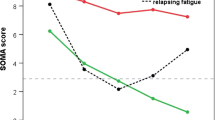Abstract
Purpose of Review
A recent review implicates that myalgic encephalomyelitis (ME), chronic fatigue syndrome (CFS), and chronic fatigue are part of the “fatigue spectrum” and recommends “longitudinal studies integrating biopsychosocial approaches to inform early management and targeted rehabilitation strategies.”
Recent Findings
ME is a neuromuscular disease distinguished by muscle fatigability (prolonged muscle weakness after minor exertion) and specific signs of neurological dysfunction. ME is not equivalent to CFS, as proposed by the authors. CFS is defined as unexplained chronic fatigue accompanied by at least four out of a list of eight specific symptoms. CFS is a distinct clinical entity and not merely a severe variant of CF, as suggested. Proof that CF, CFS, and ME are part of a “fatigue continuum” and that CF can convert to CFS at a later stage is lacking. Biopsychosocial approaches for early management and rehabilitation of CF, as promoted by the authors, are at odds with the current understandings of ME, CFS, and CF. The (bio)psychosocial explanatory models for ME and CFS have proven to be invalid, and the associated interventions, cognitive behavioral therapy and graded exercise therapy, have shown to be ineffective and even potentially harmful.
Summary
ME, CFS, and CF are three very distinct clinical entities. Interventions justified by (bio)psychosocial models appear to be unsuccessful and potentially noxious. To develop effective treatments, it is crucial to make a clear distinction between ME, CFS, and CF and to leave the (bio)psychosocial explanations and therapies behind us.
Similar content being viewed by others
References
Papers of particular interest, published recently, have been highlighted as: • Of importance •• Of major importance
Fatt SJ, Cvejic E, Lloyd AR, Vollmer-Conna U, Beilharz JE. The invisible burden of chronic fatigue in the community: a narrative review. Curr Rheumatol Rep. 2019;21(2):5. https://doi.org/10.1007/s11926-019-0804-2.
•• Dowsett EG, Ramsay AM, McCartney RA, Bell EJ. Myalgic encephalomyelitis—a persistent enteroviral infection? Postgrad Med J 1990; 66(777): 526–530. https://doi.org/10.1136/pgmj.66.777.526. This landmark article describes the last formal definition of ME and reports the symptoms experienced by 420 patients meeting this definition. The authors also pose that ME should be distinguished from a variety of other post-viral states based on the unique clinical and epidemiological pattern of symptoms and signs of ME.
Fukuda K, Straus SE, Hickie I, Sharpe M, Dobbins JG, Komaroff AL. The chronic fatigue syndrome: a comprehensive approach to its definition and study. Ann Intern Med. 1994;121(12):953–9. https://doi.org/10.7326/0003-4819-121-12-199,412,150-00009.
Acheson DE. A new clinical entity? Lancet. 1956;267(6926):789–90. https://doi.org/10.1016/S0140-6736(56)91252-1.
•• Twisk FNM. Myalgic encephalomyelitis, chronic fatigue syndrome, and systemic exertion intolerance disease: three distinct clinical entities. Challenges. 2018;9(1):19. https://doi.org/10.3390/challe9010019. This article describes the fundamental differences between ME, a neuromuscular (‘poliolike’) disease with distinctive features, CFS, an ill-defined fatigue syndrome, and SEID, which is meant to replace ME and CFS.
Hickie I, Davenport T, Wakefield D, Vollmer-Conna U, Cameron B, Vernon SD, et al. Post-infective and chronic fatigue syndromes precipitated by viral and non-viral pathogens: prospective cohort study. BMJ. 2006;333(7568):575. https://doi.org/10.1136/bmj.38933.585764.AE.
Vollmer-Conna U, Piraino BF, Cameron B, Davenport T, Hickie I, Wakefield D, et al. Cytokine polymorphisms have a synergistic effect on severity of the acute sickness response to infection. Clin Infect Dis. 2008;47(11):1418–25. https://doi.org/10.1086/592967.
Twisk FNM, Corsius LAMM. Cognitive-behavioral therapy for chronic fatigue syndrome: neither efficacious nor safe. Br J Psychiatry. 2018;213(2):500–1. https://doi.org/10.1192/bjp.2018.136.
Song S, A JL. A population-based study of chronic fatigue syndrome (CFS) experienced in differing patient groups: An effort to replicate Vercoulen et al.’s model of CFS. J Ment Health. 2005;14(3):277–89. https://doi.org/10.1080/09638230500076165.
• Maes M, Twisk FNM. Chronic fatigue syndrome: Harvey and Wessely’s (bio)psychosocial model versus a bio(psychosocial) model based on inflammatory and oxidative and nitrosative stress pathways. BMC Med. 2010;8(3):35. https://doi.org/10.1186/1741-7015-8-35. This article outlines the pillars of a biological explanatory model for ME/CFS. While many explanatory models emphasize the role of psychosocial factors, this model stresses the relevance of biological abnormalities which can plausibly explain the symptoms experienced by patients.
Author information
Authors and Affiliations
Corresponding author
Ethics declarations
Conflicts of Interest
The author declares no conflict of interest.
Additional information
Publisher’s Note
Springer Nature remains neutral with regard to jurisdictional claims in published maps and institutional affiliations.
Rights and permissions
About this article
Cite this article
Twisk, F.N.M. Myalgic Encephalomyelitis, Chronic Fatigue Syndrome, and Chronic Fatigue: Three Distinct Entities Requiring Complete Different Approaches. Curr Rheumatol Rep 21, 27 (2019). https://doi.org/10.1007/s11926-019-0823-z
Published:
DOI: https://doi.org/10.1007/s11926-019-0823-z




